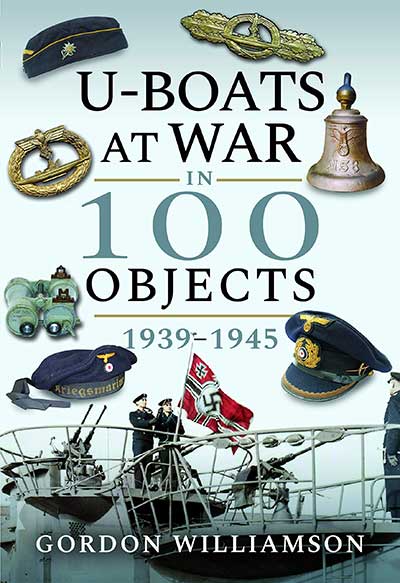U-Boats at War in 100 Objects, 1939-1945
Gordon Williamson
 Gordon Williamson offers a fresh look into the Kriegsmarine in his new book U-Boats at War in 100 Objects, 1939-1945. In 182 pages, the author of more than 50 books on military subjects presents the who, what, where, when, and why to piece together a World War II story that both educates and entertains the novice to the expert.
Gordon Williamson offers a fresh look into the Kriegsmarine in his new book U-Boats at War in 100 Objects, 1939-1945. In 182 pages, the author of more than 50 books on military subjects presents the who, what, where, when, and why to piece together a World War II story that both educates and entertains the novice to the expert.
Forgoing a chronology of historical events, Williamson highlights individual components that fit together to make a complete war machine. He does this through sensory writing, easily digestible sections that include an object or two, and a one-to-two-page fact-filled overview of them. Diverse objects of war include photographs of bunkers, weaponry, authentic passes, and propaganda posters as well as badges of honor, uniforms, and images of well-known and everyday sailors.
His multifaceted approach works well for a variety of learning styles and breathes life into his book. The reader can feel the emotions attached to an awards ceremony, the color, texture and fit of a hat on a sailor’s head, the immense stress s\sailors bore, and the often-rank smell of a crowded U-boat. In this vein, despite eschewing a chronological format, he also develops a feeling of time. The reader absorbs the many hours sailors train for the various ranks, the time it takes to introduce, retire, or perfect technology or to launch weapons and submerge the submarines, and how time eventually ran out for the Kriegsmarine.
Rather than categorize like objects into single chapters, Williamson sprinkled them throughout the book so that each turn of the page is exciting and not dulled by repetition. This allows every object, including a Type VIIC U-boat, a rare Kriegsmarine Star Globe, and a closet-sized U-boat galley, to stand out.
His object-by-object approach invites students to personally construct a period in history much like completing a jigsaw puzzle. Like the puzzle piece that is examined for its shape and place in the whole, the object is studied for its characteristics and how it fits into history. Take, for example, the descriptions and photographs of various badges; medals of honor created to give credit for numbers of tours, exemplary work, and to lift the spirits of the sailors. We learn the details of designs and the badges’ purposes, how many and to whom the badges were given, the materials used, and companies and artists who created them.
The author juxtaposed technical detail with human behavior to sculpt experiences such as in his section on equipment used for the call to nature: one or two septic tank-free bathroom facilities for many sailors, and the outdoor “toilet” that was a metal ring fastened to hang overboard the ship. We learn about U-boat plumbing and how something humankind does every day in private is not always the case on a U-boat—or an easy feat—and how maintenance and a basic human action can have deadly effects if not managed correctly. The passage is brought home by a photograph of a man perched on a metal ring over the sea.
In the end, Williamson puts within reach of a broad spectrum of readers a fascinating, complex, and multilevel story of human and technological success and failure, where life hung in the balance.
- Barnsley: Frontline Books, 2020
- 7” x 10”, hardcover, ix + 182 pages
- Photographs. $49.95
- ISBN: 9781526759023
Reviewed by Mary Ellen Riddle, Graveyard of the Atlantic Museum
